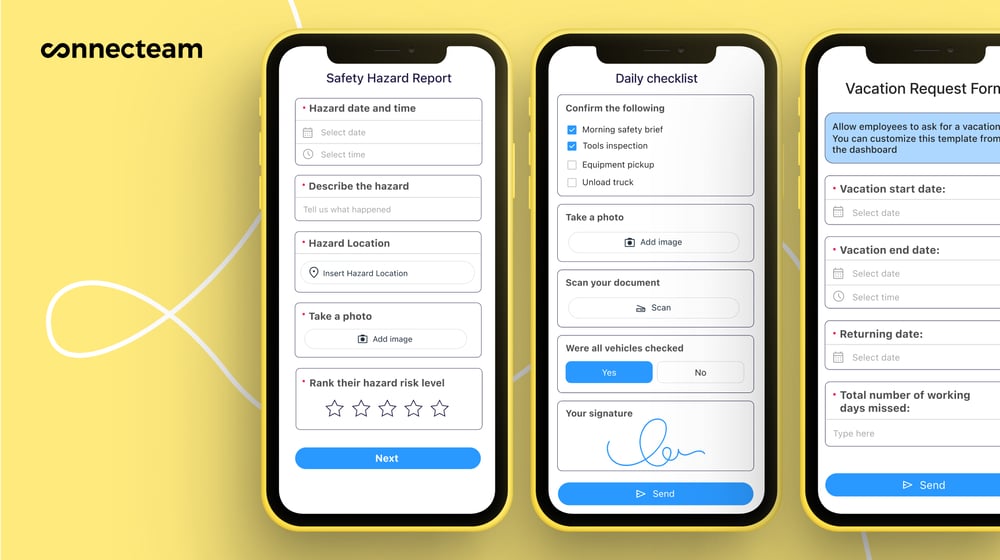Employee performance has a direct impact on safety, quality, and deadlines in a construction project, making investment in development and accountability essential.
A structured employee evaluation form that is concise yet comprehensive is your holy grail for effective, consistent performance reviews and maintaining high standards within your construction company.
In this guide, we explore the benefits and offer some top tips for conducting performance reviews, as well as what to avoid. Plus, download your free printable construction employee evaluation form template.
Key Takeaways
- Employee evaluation forms are a key performance management tool for construction employees.
- A good form should capture key details, include a clear scoring matrix, allow for employee comments, and feature a signature box.
- Preparing thoroughly, providing clear feedback, and setting SMART goals help construction workers make the most of their quarterly reviews.
Why Do Employee Evaluations Matter?
The benefits of consistent evaluations are undeniable:
- Higher revenue growth: Businesses that invest in employee development see up to 30% higher revenue growth.
- Improved tenure: 94% of employees would stay at companies longer if they invested in their development.
- Say ahead of the competition: 60% of companies with an effective performance management system have outperformed their peers in the last 3 years.
- Reduced turnover: Companies that provide regular feedback experience 14.9% lower turnover rates than those that don’t. Regular, constructive feedback through employee evaluations keeps your team engaged and prevents attrition.
Create Construction Employee Evaluations with Connecteam

Connecteam’s digital forms and checklists make it easy to manage construction employee evaluations. Build custom evaluation forms from scratch or use one of Connecteam’s pre-built templates and customize it to fit your needs.
If you already have an evaluation form that works for your team, upload or take a picture of it, and Connecteam’s AI will instantly convert it into a structured, digital version. This keeps your existing workflows but cuts out the manual data entry, so supervisors can follow the same evaluation process, just faster and more efficiently.
Flexible field types for crews on the go
Connecteam offers flexible field types designed for construction workflows, including speech-to-text functionality that lets supervisors record observations hands-free, while on the jobsite. It captures, summarizes, and organizes inputs automatically. Beyond standard text and dropdowns, you can attach photos, scan documents, and add files to log work quality, safety compliance, and project milestones in real-time.
Track every detail of field performance
Every form submission is automatically time-stamped and stored securely in the app, creating an audit trail for performance reviews, compliance tracking, and employee development conversations. This makes it easy to find past evaluations or track an employee’s progress over time.
Try Connecteam for free and start tracking field performance today!
What Every Employee Evaluation Form for a Construction Company Needs
Employee evaluation forms are flexible and can be tailored to your business’s needs. They can be used any time after a new construction hire has passed their probation.
It’s good practice to include the following categories in your evaluation form:
Basic information
Identifying information such as the employee’s name, number, site, project code, and date of evaluation is crucial for both record-keeping and audit purposes.
Goals
Use this section to document the goals previously agreed upon, measure progress towards them, and set new objectives where appropriate. If this is the first review, your priority should be agreeing on some initial goals and setting expectations. Goals should be specific, measurable, and aligned with both project needs and the employee’s professional development.
For example, instead of “Be better at project planning,” try “Submit detailed Park Street Project Plan 1 week before kickoff for supervisor review.” Another example could be shifting “Improve technical skills” to “Gain advanced safety certification and site first aid certification before next quarterly review.”
You can also use the goals section to evidence achievements over time, highlight areas where additional support or training may be required, and demonstrate how individual contributions align with company priorities.
Current performance categories
Each criterion should be scored between 1 and 5, where 5 is excellent and 1 requires significant improvement.
Work quality & skill proficiency
This section should assess how well an employee completes the assigned tasks and demonstrates trade proficiency.
Supervisors should provide a score based on observed performance and include specific, measurable examples to support the rating. For example, instead of “Score 4—Skilled worker,” try “Score 4—Operates heavy machinery safely and efficiently, with no reported incidents in the last quarter.
But, paperwork for near-misses could be better.” Ratings in this category help identify training needs and highlight areas of technical strength.
Teamwork & communication
This section measures an employee’s ability to collaborate effectively with colleagues, communicate clearly, and respond appropriately to instructions. It also captures their contribution to maintaining a positive site culture. Consider factors such as conflict resolution, information sharing, and support for less experienced team members when determining the score.
Productivity & time management
This section evaluates how effectively an employee manages their time and maintains productivity on the job site. However, on construction projects, this can be difficult to measure on an individual basis. Consider tracking punctuality, task completion, and overall output against project goals.
Pro Tip
Workforce management software like Connecteam enables you to gain valuable insights on punctuality, work hours, and task completion through time tracking and task management tools. Monitor work hours, compare planned vs. actual progress, and see how efficiently each worker contributes on the jobsite.
Safety practices
Safety is non-negotiable on a construction site. Any lapses in compliance can lead to costly delays or, worse, serious accidents. Adherence to Occupational Safety and Health Administration (OSHA) regulations, the use of personal protective equipment (PPE), the speed of reporting hazards, and consistent follow-through on safety protocols are all essential aspects to evaluate.
Performance issues related to health and safety are unlikely to be due to genuine negligence. They’re more likely due to a lack of paperwork, forgetfulness, or unclear communication. Although this may seem minor, these small oversights can add up to significant risks on a construction site. Consistent feedback is your opportunity to redress the standard before a “near miss” turns into a disaster.
It’s important to note that using inconsistent rating scales for performance categories may imply that some areas of evaluation carry greater weight than others, which shouldn’t be the case. “Productivity, safety, and teamwork are not competing priorities—they are interdependent,” says Caitlin Scannell, Director of Operations at SnapADU.
Did You Know?
Connecteam’s free smart forms and checklists tool makes it easy to create digital safety audits, inspection logs, and incident reports—all accessible from a mobile device. By digitizing these processes, you ensure nothing slips through the cracks and maintain a safe worksite.
Signature
Include a space for both you and your employee to sign and date the conversation. This step confirms that the review took place and both sides had the opportunity to discuss performance openly. It doesn’t mean the employee agrees with every point; it means they agree the form accurately reflects the discussion that took place.
Pro Tip
If you’re starting a new construction company, it’s a good idea to set up your performance review process before bringing on your first employees. This creates a culture of fairness and consistency from the outset.
Template: Construction employee review template
This form helps evaluate construction employees’ performance, safety practices, work quality, and teamwork. Use it during periodic reviews to provide structured feedback and set goals for improvement.
Construction Employee Evaluation Form
Fill the fields below, then click Download PDF.
Step-by-Step Guide to Using the Employee Evaluation Form for a Construction Company
Did You Know?
With Connecteam’s AI-powered file-to-form feature, you can upload your existing paper or PDF employee evaluation forms and instantly turn them into mobile-friendly digital forms. No manual re-entry, no formatting headaches — just upload, customize, and start using them across all your construction sites.
Prepare for the evaluation
Preparing for the evaluation ahead of time can make you feel more organized and confident, especially if the review is going to impart negative news or development opportunities. This should happen before you send the review invite. Consider preparing examples of behavior in advance, gathering performance data, and reviewing past evaluations.
You may also want to:
- Look up construction performance review examples.
- Check attendance and productivity records.
- Review construction worker job descriptions and project goals.
- Plan for career development conversations.
- Remind yourself of company welfare resources.
Taking the time to prepare for evaluations not only leads to more accurate and constructive feedback but also indicates to employees that you care about their development. At SnapADU, evaluations are taken seriously. Caitlin Scannell says, “Each individual plays a vital role in our success. Our goal is to support each person’s growth while strengthening the team as a whole.”
Schedule the review
You should then schedule the employee’s performance review. This doesn’t need to be a formal invitation; something simple like an email or quick on-site conversation will do. Check out the example below for inspiration.
Hi [Name],
I hope you’re well today.
I’m reaching out to schedule your next quarterly performance review. Your last review was on [date], so it would be good to get the next one scheduled.
I am available on [date] at [time], [date] at [time], or [date] at [time] to conduct this review. Please let me know what time works for your schedule, and we can meet at [place].
If you have any questions or need anything ahead of the meeting, please let me know.
Kind regards,
[Your name]
Giving your employee a choice of 2 or 3 specific times and dates prevents needless back-and-forth while showing respect for their schedule.
Conduct the conversation
Once the review is underway, you’ll have the conversation.
This shouldn’t be a tick-box exercise. Instead, use it as a guide to have a meaningful conversation with your employee about their recent performance and progress towards their goals. It’s your opportunity to underscore any verbal or informal feedback you’ve given throughout the quarter and document it in a structured way.
As you go through each category, mark your score and explain your reasoning. Back it up with examples, and invite the employee to share their own perspective as well. “Managers…sometimes overlook the importance of listening,” says Ed Lane, President of Lane Homes & Remodeling. “Employees often have valuable insight about challenges on the site, and when their input is dismissed it can lead to disengagement.”
Use the form to balance recognition with development. Celebrate wins and highlight improvements since the last review, while also being honest about areas that need more focus. Linking feedback to specific goals keeps the conversation constructive and future-oriented, rather than feeling like criticism.
Set improvement goals
Use your employee evaluation to review the goals set in the past review and set some new goals based on progress.
As touched upon, goals should be SMART—Specific, Measurable, Achievable, Relevant, and Time-bound. It’s reasonable to set between 1 and 3 quarterly goals and 3 to 5 annual goals. The quarterly goals should contribute in some way to the annual goals, creating a clear line of sight between day-to-day tasks and longer-term growth.
For example, if the annual goal is to improve site safety performance, a quarterly goal could be to complete a new safety certification or lead 2 toolbox talks. Similarly, if the annual goal is to develop leadership skills, a quarterly goal might be to mentor a junior colleague or take responsibility for a small project milestone.
Follow up
Once the evaluation is completed, follow up with your employee within 48 working hours.
Send them a copy of their performance review form via email, printed handout, or an app-based document sharing tool like Connecteam, along with a brief summary of the agreed-upon goals, success measures, target dates, and any training or support you’ll provide. Let them know they can contact you if they have any questions or require further support.
Ask the employee to acknowledge receipt of the form. Something as simple as, “In the absence of a physical signature, I, [name], confirm receipt of the performance review dated [date] and understand its contents.” You can then save the signed form and notes in your HR files.
How To Evaluate Productivity & Safety
“Safety is the foundation for productivity,” says Ed Lane. “A crew that follows safety practices works more confidently, with fewer delays from accidents or mistakes.”
When evaluating productivity, consider factors such as meeting deadlines, utilizing materials efficiently, and making a positive contribution to project flow. For safety, focus on compliance with OSHA regulations, proper use of PPE, hazard reporting, and consistent adherence to company-relevant safety procedures.
The key is to review both hand in hand, considering how safety impacts productivity and vice versa. For example, a worker who finishes tasks quickly (i.e., is very productive) but cuts corners on safety is a liability. Likewise, someone who is overly cautious (i.e., too safe) could risk slowing down construction tasks and progress.
Tips for Effective Construction Employee Evaluations
Use these tips to ensure your employee evaluations are as effective as possible:
Keep evaluations objective
All feedback should be based on observable behavior and feedback you can evidence. Use data from timesheets, project reports, or safety records to identify performance gaps. If you can point to the feedback, that’s usually a good steer that it’s fair and reliable.
Use evaluations to identify training needs
Consistent gaps in an employee’s skills or knowledge could be an indication that they need further training or additional support to build competence. Position this as an opportunity for growth, rather than a point of weakness.
Be specific
Vague statements like “You need to do better” or “This isn’t what we expect” aren’t helpful to anyone. Be specific, tying feedback to clear examples and outcomes. For instance, instead of saying, “Your time management needs work,” you could say, “On the last 2 concrete pours, prep was delayed because the forms weren’t ready. Let’s work on planning the setup a day earlier.”
Use the form consistently across all employees
Every employee deserves a fair and equal evaluation process. Be sure to conduct the same prep, discussion, and documentation with each employee review. Avoid bias and apply your actions consistently.
Common Mistakes To Avoid in Employee Evaluations
Watch out for these pitfalls to ensure you don’t undermine the evaluation process or damage trust with your team:
Focusing on completion, not quality
Performance reviews should dig deeper, rather than simply focusing on speed or task completion, which could inadvertently lead employees to cut corners to meet targets, potentially compromising quality, safety, and client satisfaction.
“When evaluating performance, supervisors should look beyond whether a task simply gets done,” says Ed Lane. “Quality of craftsmanship is the first priority. Is the work precise, durable, and completed to the standard the client expects?”
Too much emphasis on one-time mistakes
“A frequent mistake is placing too much weight on a single event rather than evaluating performance over time,” says Caitlin Scannell. “At SnapADU, we understand that people have highs and lows, and we look at overall patterns—not isolated missteps.”
Managers should avoid emphasizing an isolated mistake rather than offering feedback as a whole. If you’ve given feedback on a mistake, draw a line under it and move on. Instead, focus on regular check-ins, coaching, and recognition throughout the year. This will help your team see reviews as a continuation of ongoing conversations rather than a surprise judgment.
Over (or under) doing it
Conducting one big employee evaluation per year can cause important feedback to be delayed or forgotten. Equally, conducting a performance review every month can make the process feel excessive. Aim to find a rhythm that combines ongoing, informal feedback and structured, predictable reviews.
FAQs
Are employee evaluation forms useful?
Employee evaluation forms are useful for adding structure and consistency to worker reviews. They can help ensure all employees are assessed against the same criteria and provide a clear record of performance over time.
Does the foreman need employee evaluations?
Yes, every worker needs an employee evaluation, regardless of seniority. It sets company expectations, creating a culture of consistency and holding everyone to the same level of accountability. It also supports continuous improvement, making development an ongoing priority.
Can employees fill in an employee evaluation form?
A self-guided employee evaluation form can be a starting point for meaningful performance discussions. The ability to self-reflect is a vital step in your professional journey. However, this self-guided method should not replace formal evaluations conducted by supervisors, and should always be followed up with a structured conversation to ensure accountability and clarity.


